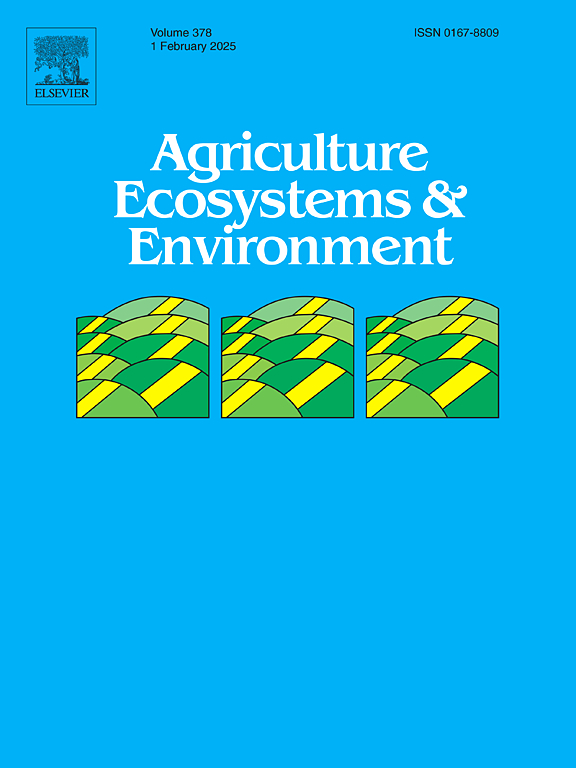Long-term effects of nutrient addition on yield, diversity, and nutritional quality in a Mediterranean grassland under variable rainfall
IF 6
1区 农林科学
Q1 AGRICULTURE, MULTIDISCIPLINARY
引用次数: 0
Abstract
Global eutrophication and increased precipitation variability affect the dynamics of Mediterranean grasslands, with significant implications for their stability, conservation, and functions, such as providing livestock feed and preserving biodiversity. This study investigates the long-term effects of multiple nutrient additions and the inter-annual precipitation variability on Mediterranean grassland productivity, diversity and nutritional quality. A long-term experiment was conducted using a randomised block design, where N, P, and K were applied in a full factorial combination. The study included two normal precipitation years (2016 and 2018, similar to the long-term average) and two dry years (2017 and 2019). We analysed the effects of nutrient addition and annual precipitation on yield, functional group composition, and plant diversity, while nutritional quality was analysed in 2019. The results reveal nutrient co-limitation effects on grassland productivity. The PK, NP and NPK treatments yielded 736.8 ± 38.1 g DM m−2, 2.6-fold higher than the remaining treatments (284.6 ± 15.7 g DM m−2). Grassland yield declined by 28 % in dry years, irrespective of nutrient addition. Annual precipitation significantly influenced plant species richness, which decreased from 18.4 species m−2 in normal precipitation years to 12.6 species m−2 in dry years. Nutrient addition, particularly NPK, provided grasses a competitive advantage, leading to lower plant species richness. The interaction between nutrient addition and annual precipitation influenced legume abundance, with a positive response observed under P and PK treatments, depending on water availability. The proportion of forbs, and the Shannon-Wiener index showed particularly low values in dry years under NPK treatment. Nutrient addition had no significant effect on grassland nutritional quality. These findings underline the long-term effects of multiple nutrient additions and reduced precipitation on Mediterranean grassland diversity and productivity, providing valuable insights for management and conservation policies to sustain these ecosystems under changing environmental conditions.
降雨条件下地中海草地养分添加对产量、多样性和营养品质的长期影响
全球富营养化和降水变异性的增加影响着地中海草原的动态,对其稳定性、保护和功能(如提供牲畜饲料和保护生物多样性)产生重大影响。本研究探讨了多种养分添加和年际降水变化对地中海草地生产力、多样性和营养质量的长期影响。采用随机区组设计进行了一项长期实验,其中N、P和K以全因子组合施用。该研究包括两个正常降水年(2016年和2018年,与长期平均水平相似)和两个干旱年(2017年和2019年)。2019年,我们分析了养分添加和年降水量对产量、功能基团组成和植物多样性的影响,并分析了营养品质。结果揭示了养分对草地生产力的共同限制效应。PK、NP和NPK处理的产量为736.8 ± 38.1 g DM m−2,是其余处理(284.6 ± 15.7 g DM m−2)的2.6倍。在干旱年份,无论添加多少养分,草地产量都下降了28% %。年降水量显著影响植物物种丰富度,从正常降水年的18.4种m−2减少到干旱年的12.6种m−2。营养物添加,特别是氮磷钾,为禾草提供了竞争优势,导致植物物种丰富度降低。养分添加和年降水量的交互作用影响豆科植物丰度,在磷和PK处理下观察到正响应,具体取决于水分有效性。在干旱年份,氮磷钾处理的牧草比例和Shannon-Wiener指数特别低。添加养分对草地营养品质无显著影响。这些发现强调了多种营养添加和降水减少对地中海草地多样性和生产力的长期影响,为在不断变化的环境条件下维持这些生态系统的管理和保护政策提供了有价值的见解。
本文章由计算机程序翻译,如有差异,请以英文原文为准。
求助全文
约1分钟内获得全文
求助全文
来源期刊

Agriculture, Ecosystems & Environment
环境科学-环境科学
CiteScore
11.70
自引率
9.10%
发文量
392
审稿时长
26 days
期刊介绍:
Agriculture, Ecosystems and Environment publishes scientific articles dealing with the interface between agroecosystems and the natural environment, specifically how agriculture influences the environment and how changes in that environment impact agroecosystems. Preference is given to papers from experimental and observational research at the field, system or landscape level, from studies that enhance our understanding of processes using data-based biophysical modelling, and papers that bridge scientific disciplines and integrate knowledge. All papers should be placed in an international or wide comparative context.
 求助内容:
求助内容: 应助结果提醒方式:
应助结果提醒方式:


